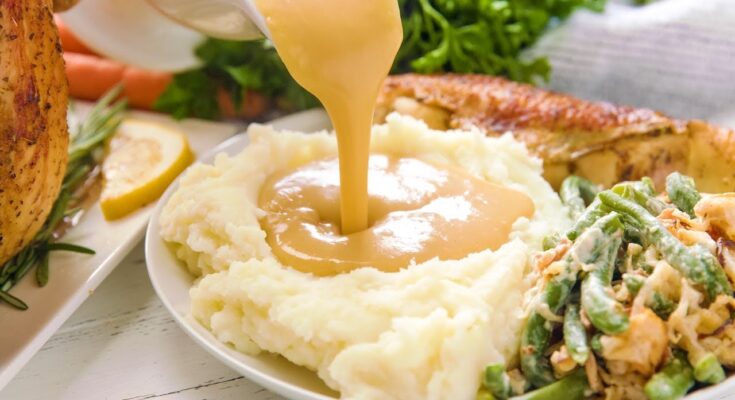Gravy Recipe: Gravy is one of those kitchen essentials that can turn a regular meal into something extraordinary. Whether you’re enjoying a roast dinner, mashed potatoes, or biscuits, a delicious, well-made gravy elevates the dish to new heights. The best part? It’s surprisingly easy to make at home! From classic brown gravy to creamy white versions, you can tweak the recipe to suit any meal or dietary preference.
In this guide, I’ll walk you through a foolproof, step-by-step process to make smooth, flavorful gravy. Along the way, you’ll also find expert tips, ways to fix mistakes, and creative ideas to customize your gravy. Let’s get started!
Ingredients for Making Gravy
To whip up a basic gravy, you’ll need only a handful of pantry staples. Here’s a quick look at the essentials:
Basic Ingredients:
- Butter: Helps create a rich, smooth roux.
- All-purpose flour: Used to thicken the gravy.
- Broth (beef, chicken, or vegetable): Adds flavor to the gravy.
- Salt and pepper: Essential seasonings to balance the taste.
Optional Add-ins for Flavor Boost:
- Cream or milk: For making creamy white gravy.
- Herbs (thyme, rosemary): Add depth and fragrance.
- Onions and garlic: Enhance savory notes.
Feel free to experiment with these ingredients based on what’s available or your flavor preferences!
Tools You’ll Need to Prepare Gravy
Having the right tools makes the process much smoother. Here’s what you’ll need:
- Whisk: Helps mix the ingredients without forming lumps.
- Saucepan: A medium-sized pan works best for gravy.
- Measuring cups and spoons: To get the proportions right.
- Strainer (optional): Useful if your gravy develops lumps.
- Gravy boat: A fancy way to serve your homemade gravy!
Types of Gravy to Explore
Traditional Brown Gravy
Brown gravy is a rich, savory sauce made using beef or chicken broth. It’s a staple for Thanksgiving dinners and roast meals. Drippings from cooked meat enhance the flavor and deepen the color of the gravy.
Creamy White Gravy
If you’re a fan of Southern-style cooking, white gravy will be your favorite. Made with milk or cream, it’s often served with biscuits or fried chicken. It has a smooth, mild taste, making it perfect for comfort food lovers.
Vegetarian and Vegan Gravy
You can easily make a plant-based gravy using vegetable broth, olive oil, and flour. Season it with herbs like thyme and sage to bring out a hearty, savory flavor without the need for animal-based ingredients.
Step-by-Step Guide to Making Basic Gravy
Step 1: Make a Roux
Start by melting 2 tablespoons of butter in a saucepan over medium heat. Once melted, whisk in 2 tablespoons of flour. Keep stirring continuously for about 2 minutes until the mixture turns golden brown. This is your roux, the thickening base for the gravy.
Step 2: Add Liquid Gradually
Slowly pour 2 cups of broth into the roux, whisking constantly. Adding the liquid gradually ensures the gravy remains smooth without any lumps. You can use chicken, beef, or vegetable broth, depending on the dish you’re preparing.
Step 3: Season the Gravy
Once the broth is fully incorporated, season with salt and pepper to taste. You can also toss in herbs like thyme or rosemary for an extra layer of flavor. Keep tasting and adjusting until it feels just right.
Step 4: Let It Thicken
Bring the mixture to a gentle simmer and cook for 5-7 minutes, whisking occasionally. You’ll notice the gravy thickening into a smooth, velvety texture. If it becomes too thick, add a bit more broth to loosen it.
Tips to Avoid Lumps in Gravy
- Whisk continuously while adding the liquid to prevent clumps from forming.
- If lumps appear, strain the gravy through a fine mesh sieve before serving.
- Use room-temperature broth to help the ingredients combine smoothly.
Customizing Your Gravy
Want to add some flair to your gravy? Try these ideas:
- Garlic and onion powder: For a savory kick.
- A splash of red wine: Perfect for roast beef gravy.
- Cream or milk: Creates a richer, smoother texture.
How to Store and Reheat Gravy
Gravy can be stored in the refrigerator for up to 3 days. If you make a big batch, it can also be frozen for up to 3 months. When reheating, warm it gently over low heat, whisking constantly to restore the original texture.
What to Serve with Gravy
Classic Pairings
- Mashed potatoes – A match made in heaven.
- Roast meats – Drizzle gravy over roast chicken, turkey, or beef.
- Biscuits – Nothing beats Southern biscuits smothered in white gravy.
Creative Uses of Gravy
- Use gravy as a sauce for hot sandwiches or casseroles.
- Drizzle it over fries for a poutine-style dish.
How to Make Gravy Without Drippings
If you don’t have meat drippings, no problem! Simply use store-bought broth as the liquid base. Adding a dash of soy sauce or Worcestershire sauce can mimic the umami flavor found in meat-based gravies.
Troubleshooting Common Gravy Problems
- Too thin? Add a slurry of flour and water to thicken.
- Too thick? Stir in more broth or milk to loosen it up.
- Lacking flavor? A pinch of salt or a splash of soy sauce can do wonders.
Healthier Gravy Alternatives
If you’re watching your calories, you can make a low-fat version using olive oil instead of butter and whole-wheat flour. For gluten-free gravy, swap out regular flour for cornstarch or a gluten-free blend.
FAQs about Gravy Recipe
1. What are the basic ingredients needed for making gravy?
The essential ingredients for a classic gravy include fat (butter or drippings from cooked meat), flour, and a liquid base such as stock, broth, or milk. Seasonings like salt, pepper, and herbs are added for flavor.
2. How do you prevent lumps in your gravy?
To avoid lumps, whisk the flour into the fat to create a smooth paste known as a roux before slowly adding your liquid. Whisk continuously while pouring the liquid to ensure it blends smoothly with the roux.
3. Can gravy be made in advance?
Yes, gravy can be prepared ahead of time and refrigerated for up to two days. Reheat it over low heat while stirring occasionally. If the gravy thickens too much, you can thin it with a little extra broth or water.
4. Is it possible to make gravy without meat drippings?
Absolutely! For a vegetarian option, use butter or oil as your fat and vegetable broth as your liquid. Season well to compensate for the flavor usually provided by the meat drippings.
5. What are some ways to enhance the flavor of gravy?
Consider adding a splash of wine, some minced garlic or onion, a bit of mustard, or Worcestershire sauce during the cooking process. Fresh herbs like rosemary, thyme, or sage also add a wonderful depth of flavor.
6. How can I thicken gravy that’s too thin?
If your gravy is too thin, make a slurry by mixing equal parts cold water and flour. Gradually whisk this into your simmering gravy until the desired thickness is achieved.
7. Can gravy be frozen for later use?
Yes, gravy can be frozen for up to four months. Store it in airtight containers or freezer bags. Thaw in the refrigerator overnight and reheat slowly on the stove, stirring often to maintain a smooth consistency.
Conclusion
Making gravy from scratch is easier than it seems. With just a few basic ingredients and simple techniques, you can create a sauce that adds warmth and richness to any meal. Whether you’re preparing a traditional brown gravy, a creamy white version, or a vegan alternative, this guide ensures your gravy game is on point every time.
References
For those interested in delving deeper into the art of making gravy or seeking additional validation for the techniques and tips shared in our article, the following resources are invaluable:
- The Culinary Institute of America: A leading authority in culinary education, their website offers comprehensive guides and professional insights into making perfect gravy. Explore more at CIA’s Official Website.
- Serious Eats: Known for their rigorous approach to recipe testing, Serious Eats provides a scientific breakdown of what makes a good gravy, complete with step-by-step instructions. Visit their detailed guide here.
- Epicurious: A treasure trove of recipes from seasoned chefs, Epicurious also features user reviews which can be helpful in understanding common pitfalls and tips. Find their gravy recipes at Epicurious Recipes.
These sources are renowned for their credibility and depth of information, making them excellent for both novices and experienced cooks looking to refine their gravy-making skills.



